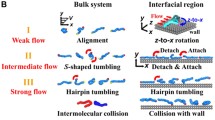Summary
A three-component model of molecular dynamics in polymer melts is described. Starting from elementary processes such as the rearrangement of local defects which is directly accessible to thermal activation, longitudinal chain diffusion (reptation) and conformational fluctuations of the surrounding tube are defined as secondary motions.
The three time parameters of the components show specific dependences on the molecular weight. Experimental evidence for the model and, on the other hand, the possibility to study individual components are achieved by the aid of mixtures of protonated chains with a molecular weightM 1 in a matrix of deuterated chains with a molecular weightM 2. The appropriate choice ofM 1 andM 2 allows to shift components outside of the experimentally accessible frequency range (104 to 108 Hz). Experimental data for diverse polyethylene fractions are presented and described by the model. The correlation length ℓ has been calculated an the basis of the fitted parameters. The result is ℓ = 8 Å.
Zusammenfassung
Ein Dreikomponentenmodell der molekularen Dynamik in Polymerschmelzen wird beschrieben. Ausgehend von Elementarprozessen wie der Umlagerung lokaler Defekte, die unmittelbar der thermischen Aktivierung unterliegt, werden als Sekundärprozesse die longitudinale Kettendiffusion (reptation) und Konformationsfluktuationen der Umgebungsröhre definiert.
Die drei Zeitparameter der Komponenten hängen spezifisch vom Molekulargewicht ab. Eine experimentelle Bestätigung sowie die Möglichkeit, einzelne Komponenten getrennt zu untersuchen, ergibt sich durch Einlagerung von protonierten Ketten des MolekulargewichtsM 1 in eine Matrix aus deuterierten Ketten des MolekulargewichtsM 2. Die geeignete Wahl vonM 1 undM 2 erlaubt es, einzelne Komponenten aus dem Meßbereich (104 bis 108 Hz) herauszuverlagern. Es wird über Meßdaten für verschiedene Polyäthylenfraktionen berichtet. Die Korrelationslänge ℓ wird abgeschätzt zu ℓ = 8 Å.
Similar content being viewed by others
References
deGennes, P. G., J. Chem. Phys.55, 572 (1971).
Kimmich, R., Polymer18, 233 (1977).
Kimmich, R., Colloid & Polymer Sci.252, 786 (1974),254, 918 (1976).
Kimmich, R., W. Doster, J. Polymer Sci. (Polymer Physics Ed.),14, 1671 (1976).
Chandrasekhar, S., Rev. Mod. Phys.15, 1 (1943).
Kimmich, R., Polymer16, 851 (1975).
deGennes, P. G., Marcromolecules9, 587 (1976).
Klein, J. Macromolecules11, 852 (1978).
Edwards, S. F., J. W. V. Grant, J. Phys. A.: Math. Nucl. Gen.6, 1169 (1973).
Voigt, G., R. Kimmich, Progr. Colloid & Polymer Sci.66, 273 (1979).
Koch, H., R. Kimmich, Polymer20, 132 (1979).
Stuart, H. A., Molekülstruktur, Springer-Verlag (Berlin, 1967).
Klein, J., Nature271, 143 (1978).
Kimmich, R., Kh. Schmauder, Polymer18, 239 (1977).
Author information
Authors and Affiliations
Additional information
With 7 figures and 1 table
Rights and permissions
About this article
Cite this article
Kimmich, R., Koch, H. Three component model of molecular dynamics in polyethylene melts —a nuclear magnetic relaxation study. Colloid & Polymer Sci 258, 261–268 (1980). https://doi.org/10.1007/BF01466665
Received:
Issue Date:
DOI: https://doi.org/10.1007/BF01466665




